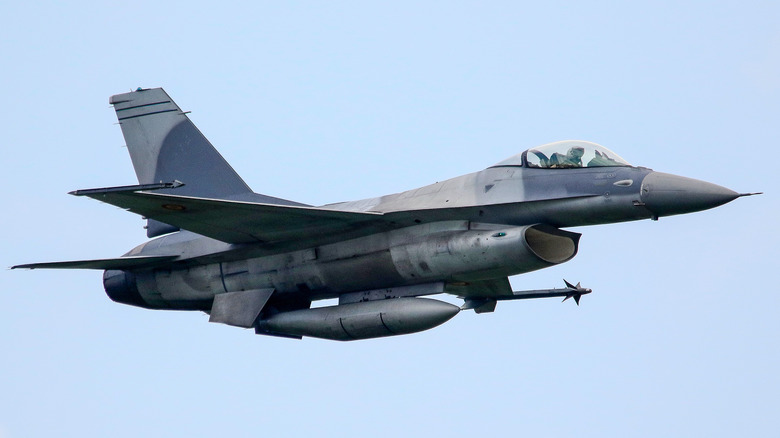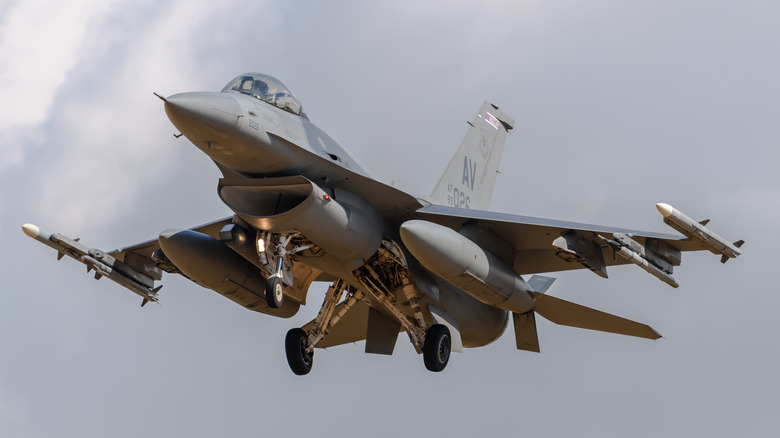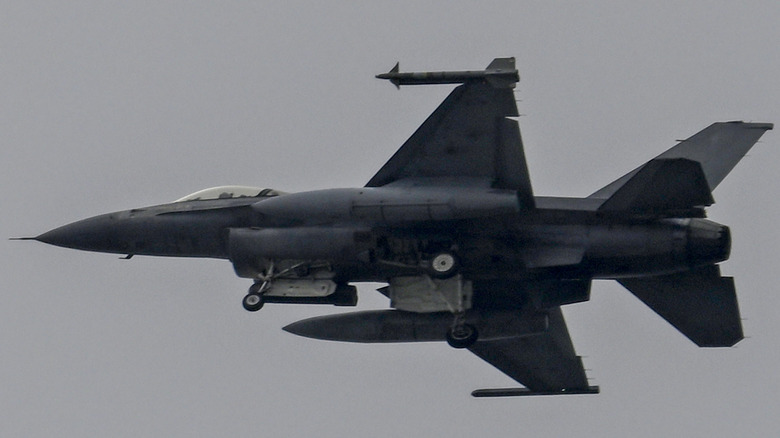The Biggest Strengths And Weaknesses Of F-16 Fighter Jets
The General Dynamics F-16 Fighting Falcon is a fourth-generation single-engine all-weather iconic fighter jet with multiple role capabilities, including fighter interception, air-to-ground bombing, and much more. The aircraft first entered service in 1979 following several years of flight testing. The project began in 1974 under General Dynamics before Lockheed took over production in the 1990s. While it's no longer produced for domestic use, the F-16 is a popular export aircraft, and since its introduction, over 4,600 F-16s have rolled off the assembly line.
While the F-16 is a legacy aircraft compared to modern fifth-generation fighters like the F-22 and F-35, it continues to operate for nations around the world. The F-16 reentered public discourse following Russia's invasion of Ukraine in 2022. Ukraine requested F-16s from the U.S. and its allies, leading many in the United States to wonder why they'd want an aircraft that's been around for 50 years. The reason is simple: The F-16 is a workhorse multi-role aircraft that would significantly enhance Ukraine's air combat capabilities, ideally giving Ukraine air superiority over Russia.
The F-16 may have been flying since the 1970s, but there's a reason it's still around. The aircraft has undergone numerous refits over the years, making it a more modern platform with increased capabilities. While it's a versatile aircraft capable of operating in many environments, the F-16 has many strengths and weaknesses that indicate it has a steep hill to climb should it take on Russia's more advanced Su-35 and MIG-31 aircraft in the skies over Ukraine.
What makes the F-16 a desirable fighter in the 21st century
So many F-16s have been built that it's the most common fixed-wing combat aircraft in military service around the world. This is due to the aircraft's relative ease of use and demonstrated abilities in and out of combat for half a century. The F-16 was designed and built for a single purpose: Dogfighting. This was meant to counter the threat from the Soviet Union and elsewhere, where larger, faster fighters demonstrated superior dogfighting abilities.
The F-16 was designed with this in mind and was intended as a potential aircraft for export to U.S. allies. Some innovations built into the F-16 include its raised cockpit with a large frameless bubble canopy, offering a more expansive view of the airspace. Additionally, the F-16 can handle 9Gs in a dogfight and features a reclined cockpit seat to help compensate for the G-forces. The F-16 also removed a central control stick between the pilot's legs, opting for a joystick-style flight controller mounted on the right side of the cockpit.
The F-16 also innovated a standard technology today known as "fly-by-wire," which uses a flight computer to make adjustments to the aircraft during flight. This makes the F-16 easier to fly, prevents stalling, and makes it more maneuverable. This was a significant advancement that's now found in just about anything and everything that flies. On top of these base features, the F-16 boasts an internal M61A1 20 mm Vulcan cannon and 11 hardpoints capable of carrying various bombs, missiles, rockets, and more.
The F-16 has several weaknesses compared to modern fighters
Because the F-16 is a legacy aircraft, it has some shortcomings when compared to modern fifth-generation platforms. First and foremost is its radar, which comes in various forms depending on the aircraft variant. While upgrades have improved the F-16's radar capabilities, it has a limited range compared to more advanced aircraft. This means that it needs to get closer to an enemy aircraft to get a target lock, and while it does this, it's likely flying within the range of the target, making it more vulnerable to air-to-air attack.
Despite this vulnerability, F-16s continue to operate successfully against all manner of combatants around the world. In 2015, a Turkish F-16 successfully shot down a Syrian Sukhoi Su-24, and that's one of many examples. Still, while it has had some successes in combat, the F-16 has one major hindrance limiting its operability in combat: Limited range. The F-16 has a relatively small fuel capacity, limiting its combat radius to 300-400 miles. This is considerably smaller than the F-35C, which has a combat radius of around 680 miles.
The F-16 requires mid-air fueling to operate in most environments, which limits its effectiveness. It also potentially endangers refueling aircraft should they enter a combat zone, so range is a significant limitation for the F-16. External fuel tanks are available, but adding them to the airframe significantly increases its weight, diminishing its maneuverability and dogfighting capabilities. Despite these weaknesses, the F-16 remains a proven platform capable of sustaining air operations around the world for the foreseeable future.


